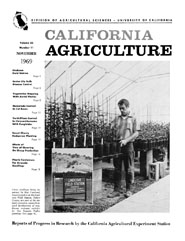Calag Archive
Calag Archive

Cover:
Citrus seedlings being examined by Ray Copeland, Superintendent at the Lindcow Field Station, Tulare County, are part of the station’s extensive research toward development of new, disease resistant varieties for San Joaquin Valley plantings.
November 1969
Volume 23, Number 11
Volume 23, Number 11


